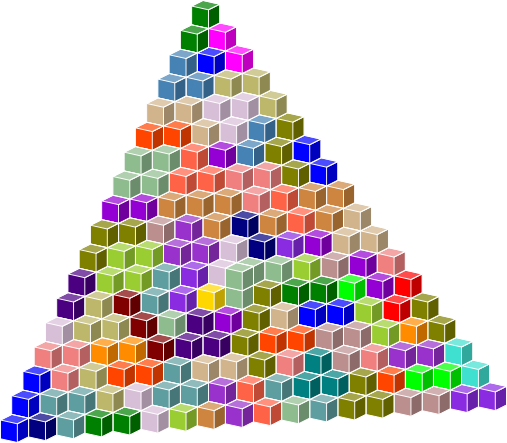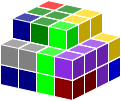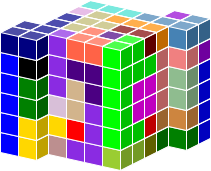Polycubes: Puzzles & Solutions
| Author: | David Goodger <goodger@python.org> |
|---|---|
| Date: | 2018-09-05 |
| Revision: | 654 |
| Web site: | http://puzzler.sourceforge.net/ |
| Copyright: | © 1998-2015 by David J. Goodger |
| License: | GPL 2 |
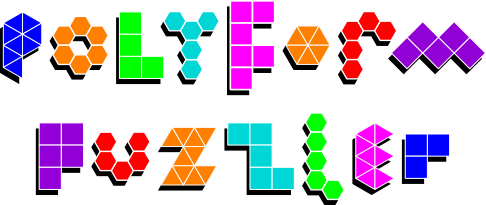
Contents
High-quality hardwood sets of these polycubes are available from Kadon Enterprises: Super Deluxe Quintillions (pentacubes) and Poly-4 Supplement (polycubes 1-4).
Tetracubes
The 8 tetracubes are composed of 32 unit cubes.
2x4x4 solid: 1390 solutions (X3D model)

2x2x8 solid: 224 solutions (X3D model)

Two 2x2x4 solids: 10? solutions (X3D model)

Soma Cubes
It is a beautiful freak of nature that the seven simplest irregular combinations of cubes can form a cube again. Variety growing out of unity returns to unity. It is the world's smallest philosophical system.
—Piet Hein
Soma Cubes include all non-convex polycubes of order 3 (1) and 4 (6). They were invented by Piet Hein in 1933. The 7 Soma cubes are composed of 27 unit cubes. Many of the designs below are from the Thinkfun Block By Block challenge cards. The two castles are from Dennis Nehen's Soma Cube pages.
If we consider the "a" and "b" pieces (a chiral pair) to be interchangeable in reflection, there are exactly half as many solutions as shown for each of the puzzles below. In other words, we can consider two solutions that are mirror reflections of each other to count as only one solution, but only if we allow pieces "a" and "b" to be exchanged (in the counts that follow, we don't allow this).

3x3x3 cube: 240 solutions (X3D model) |

Bathtub: 158 solutions (X3D model) |
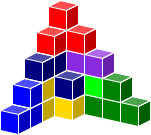
Cornerstone: 10 solutions (X3D model) |

Crystal: 2800 solutions (X3D model) |

Curved Wall: 66 solutions (X3D model) |

High Wall: 46 solutions (X3D model) |

Long Wall: 104 solutions (X3D model) |

Skew 1: 244 solutions (X3D model) |

Skew 2: 14 solutions (X3D model) |

Sofa: 32 solutions (X3D model) |

Steamer: 152 solutions (X3D model) |

Steps: 164 solutions (X3D model) |

Tunnel: 26 solutions (X3D model) |

Screw (not self-supporting!): 14 solutions (X3D model) |

Clip: 20 solutions (X3D model) |

Pyramid: 14 solutions (X3D model) |

Castle 1: 10 solutions (X3D model) |

Castle 2: 10 solutions (X3D model) |
Diabolical Cube
The Diabolical Cube puzzle dates from the 19th century, published in Puzzles Old and New by Professor L. Hoffmann, London 1893. The puzzle contains one piece from each of the solid polyominoes of orders 2 through 7 (i.e one solid domino, ..., one solid heptomino), for a total of 27 unit cubes. More info in The Puzzling World of Polyhedral Dissections.
Original: 13 solutions (X3D model)

Nancy Sheldon's variations:
Replace the 'U' pentomino with a 'P' pentomino (lowers surface area): 146 solutions (X3D model)

Replace the 'L' heptomino with a 'T' heptomino (increases symmetry): 16 solutions (X3D model)

Both substitutions combined (1 & 2 above): 43 solutions (X3D model)

Polycubes of Order 2 Through 4
These puzzles use the 1 dicube, 2 tricubes, and 8 tetracubes, for a total of 40 unit cubes.
Solids:

5x4x2: solutions incomplete (X3D model)

10x2x2: solutions incomplete (X3D model)

2x5x2x2: solutions incomplete (X3D model)
Open boxes (closed on the bottom):

4x4x3: solutions incomplete (X3D model)

6x4x2: solutions incomplete (X3D model)
Aztec pyramid (stacked Aztec diamonds): solutions incomplete (X3D model)

Steps:
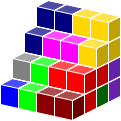
4x4x4: solutions incomplete (X3D model)

6x5x2 (design by Kaito Goodger): solutions incomplete (X3D model)
Ring walls:

6x6x2: solutions incomplete (X3D model)

7x5x2: solutions incomplete (X3D model)

8x4x2: solutions incomplete (X3D model)

9x3x2: solutions incomplete (X3D model)

4x3x4: solutions incomplete (X3D model)

3x3x5: solutions incomplete (X3D model)
Cross (or doubled X pentacube): solutions incomplete (X3D model)

Cross towers:

design by Kaito Goodger: solutions incomplete (X3D model)
Stacked squares: solutions incomplete (X3D model)

Towers:

design by Kaito Goodger: solutions incomplete (X3D model)
Polycubes of Order 1 Through 4
These puzzles use the 1 monocube, 1 dicube, 2 tricubes, and 8 tetracubes, for a total of 41 unit cubes.
Stacked squares:
7x3x2 solid (with a hole): solutions incomplete (X3D model)

3x3x5 towers (with gaps):
Open boxes (closed on the bottom):

3x3x5: solutions incomplete (X3D model)

5x5x2: solutions incomplete (X3D model)
Cross tower: solutions incomplete (X3D model)
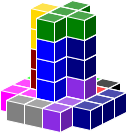
Polycubes of Order 1 Through 5
These puzzles use the 1 monocube, 1 dicube, 2 tricubes, 8 tetracubes, and 29 pentacubes, for a total of 186 unit cubes.
2x3x31 solid: solutions incomplete (X3D model)

11x3x6 solids (with holes/bites):
X (designed for G4G10):

Built with Kadon's Super Deluxe Quintillions and Poly-4 Supplement. Click for the full-size image.
Cube clusters:

solutions incomplete (3 empty unit cubes in the middle; not self-supporting; X3D model)
Overlapping blocks
Pyramid: solutions incomplete (X3D model)

Cross blocks:
Diamond wall: solutions incomplete (X3D model)

Solid Hexominoes
These puzzles use the 35 solid hexominoes (planar hexacubes), for a total of 210 unit cubes.
13x5x4 stepped block (design from Andrew Clarke's Poly Pages): solutions incomplete (X3D model)

9x5x8 stepped block: solutions incomplete (X3D model)

9x9x3 block 1 (design from Andrew Clarke's Poly Pages; central cube in middle layer is empty): solutions incomplete (X3D model)

9x9x3 block 2 (design from Andrew Clarke's Poly Pages): solutions incomplete (X3D model)

Solid Hexominoes Plus
These puzzles use the 35 solid hexominoes (planar hexacubes), plus a second copy of the N06 piece (called S16), for a total of 216 unit cubes (which equals 6³).
6x6x6 cube (6³): solutions incomplete (X3D model)

11x6x6 steps: solutions incomplete (X3D model)

6³ Cubes: Polycubes of Order 1 Through 5 Plus Select Hexacubes
These puzzles use the 1 monocube, 1 dicube, 2 tricubes, 8 tetracubes, 29 pentacubes, and a selection of 5 hexacubes, for a total of 216 unit cubes (which equals 6³). The 5 hexacubes chosen (arbitrarily, as "the five most interesting") are as follows. (Names in parentheses are from Kadon's hexacube naming system.):

Ba6 (B) |

Nt6 (N2b3) |

O06 (O) |

Qe6 (Q4b1) |

Tp6 (T4b4) |
This set of polycubes was selected because it can be used to illustrate both sides of the first solution to the Diophantine 3.1.3 equation (the only solution consisting of consecutive integers):
3³ + 4³ + 5³ = 6³
3³ + 4³ + 5³ cubes: solutions incomplete (X3D model)
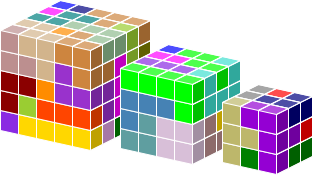
6³: solutions incomplete (X3D model)

For more on this curious equation and dissection puzzle, see:
Hexacubes & Pentacubes
These puzzles use the 29 pentacubes and 166 hexacubes, for a total of 1141 unit cubes.
Crystal 1 (18×18×18 triangular pyramid, plus one unit cube centered on the crystal face): solutions incomplete (X3D model). Based on the "Mega-Pyramid" puzzle designed by Andy Niedermaier.
